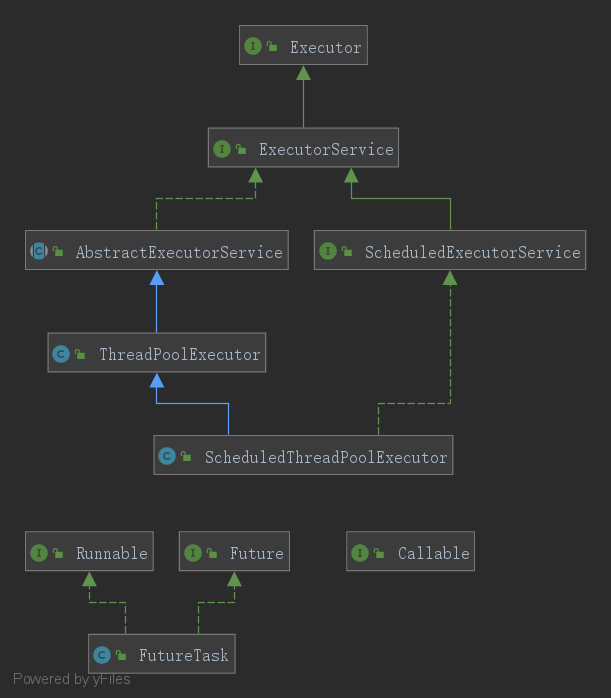Executor框架
前面讲的ThreadPoolExecutor其实是Executor框架中的一员。从JDK 5开始,把工作单元与执行机制分离开来。工作单元(可执行的任务)包括Runnable和Callable,而执行机制由Executor提供。
Executor框架成员及其体系

以上就是Executor框架的一个简版UML,生成此图时发现其中还有其他成员,直接参考《java并发编程艺术》移除了。
Executor框架共有三大成员+一工具类
Executor
他负责任务的执行, 主要包括如下两个实现类
ThreadPoolExecutor
使用Executors可以创建三种ThreadPoolExecutor,分别如下:
- SingleThreadExecutor:创建只有单个线程的线程池
- FixedThreadPool:用于创建固定线程数量的线程池
- CachedThreadPool:创建一个会根据需要创建新线程的线程池
- ScheduledThreadPoolExecutor:
ScheduledThreadPoolExecutor
它主要用来在给定的延迟之后运行任务,或者定期执行任务
ScheduledThreadPoolExecutor适用于需要多个后台线程执行周期任务,同时为了满足资源管理的需求而需要限制后台线程的数量的应用场景。
任务
包括Runnable和Callable, 一个表示没有返回结果的任务,一个表示有返回结果的任务,这个我们太熟悉了
任务执行结果
包括Future接口及其实现类FutureTask,这个也是我们的老朋友了
Executors
他是一个工具类,就像Arrays和Collections, 他是一个创建各种ThreadPoolExecutor的工具
ThreadPoolExecutor详解
ThreadPoolExecutor的创建前面已经讲过了,里边涉及到很多的参数,这里不再赘述。这里主要是探讨Excutors为我们提供了几种实用ThreadPoolExecutor
FixedThreadPool
他的源码如下:
public static ExecutorService newFixedThreadPool(int nThreads, ThreadFactory threadFactory) {
return new ThreadPoolExecutor(nThreads, nThreads,
0L, TimeUnit.MILLISECONDS,
new LinkedBlockingQueue<Runnable>(),
threadFactory);
}
他的特点是
- 核心线程数和最大线程数是相等的
- 线程保活时间是0,就是说执行完,线程会被立即销毁
- 工作队列是使用的有界队列LinkedBlockingQueue,这个队列的界在Inter.MAX_VALUE, 这意味这他通常不会因为任务数量过多拒绝任务
SingleThreadExecutor
他的源码如下:
public static ExecutorService newSingleThreadExecutor(ThreadFactory threadFactory) {
return new FinalizableDelegatedExecutorService
(new ThreadPoolExecutor(1, 1,
0L, TimeUnit.MILLISECONDS,
new LinkedBlockingQueue<Runnable>(),
threadFactory));
}
他的特点是:
- 核心线程数和最大线程数都是1
- 线程保活时间是0,就是说执行完,线程会被立即销毁,重新创建
- 工作队列也是使用的LinkedBlockingQueue
CachedThreadPool
public static ExecutorService newCachedThreadPool(ThreadFactory threadFactory) {
return new ThreadPoolExecutor(0, Integer.MAX_VALUE,
60L, TimeUnit.SECONDS,
new SynchronousQueue<Runnable>(),
threadFactory);
}
他的特点是:
- 没有核心线程,可以无限的创建线程
- 工作队列使用SynchronousQueue, 这是一个不存储元素的队列, 这意味着,提交一个任务必须要等这个任务被消费(可能创建新线程消费,也可能是被老线程消费),下一个任务才进去执行;线程从队列获取任务时,一定要阻塞到有任务提交进去。
- 线程的保活时间时60秒,意味着60秒没任务就会被销毁
ScheduledThreadPoolExecutor
它主要用来在给定的延迟之后运行任务,或者定期执行任务。
两个示例
以一定的周期执行任务
public class Demo_06_02_1_Exexutors {
public static void main(String[] args) {
ScheduledExecutorService scheduledExecutorService = Executors.newScheduledThreadPool(4);
scheduledExecutorService.scheduleAtFixedRate(() -> {
System.out.println("欢迎关注微信公众号'大雄和你一起学编程'"+new Date());
try {
Thread.sleep(10000);
} catch (InterruptedException e) {
e.printStackTrace();
}
}, 3, 1, TimeUnit.SECONDS);
}
}
// 这段代码会在启动后3秒开始输出,然后每隔10秒输出一次
// 欢迎关注微信公众号'大雄和你一起学编程'Fri May 08 09:36:50 CST 2020
// 欢迎关注微信公众号'大雄和你一起学编程'Fri May 08 09:37:00 CST 2020
// 欢迎关注微信公众号'大雄和你一起学编程'Fri May 08 09:37:10 CST 2020
// 欢迎关注微信公众号'大雄和你一起学编程'Fri May 08 09:37:20 CST 2020
public class Demo_06_02_2_Exexutors {
public static void main(String[] args) {
ScheduledExecutorService scheduledExecutorService = Executors.newScheduledThreadPool(4);
scheduledExecutorService.scheduleWithFixedDelay(() -> {
System.out.println("欢迎关注微信公众号'大雄和你一起学编程'"+new Date());
try {
Thread.sleep(10000);
} catch (InterruptedException e) {
e.printStackTrace();
}
}, 3, 1, TimeUnit.SECONDS);
}
}
// 这段代码会在启动后3秒开始输出,然后每隔10+1秒输出一次
// 欢迎关注微信公众号'大雄和你一起学编程'Fri May 08 09:40:18 CST 2020
// 欢迎关注微信公众号'大雄和你一起学编程'Fri May 08 09:40:29 CST 2020
// 欢迎关注微信公众号'大雄和你一起学编程'Fri May 08 09:40:40 CST 2020
// 欢迎关注微信公众号'大雄和你一起学编程'Fri May 08 09:40:51 CST 2020
这两者的区别大家可以体会下
ScheduledThreadPool 有四种方式创建
public static ScheduledExecutorService newScheduledThreadPool(int corePoolSize)
public static ExecutorService newSingleThreadExecutor()
// 还有两个是可以指定线程工厂
提交任务主要有两种方式
// 他会每间隔一个固定时间执行一次,如果你的任务执行时间<=你给定的period, 那么每隔period时间会执行一次
// 如果你的任务执行时间>你给的period, 那么任务执行完就开始下一次
public ScheduledFuture<?> scheduleAtFixedRate(Runnable command,
long initialDelay,
long period,
TimeUnit unit)
// 他不管你的任务执行时间,任务执行完了再隔delay时间执行下一次任务
public ScheduledFuture<?> scheduleWithFixedDelay(Runnable command,
long initialDelay,
long delay,
TimeUnit unit)
原理
这个定时任务的核心就是使用DelayQueue,但是他不是使用的concurrent包的那个DelayQueue, 而是自己封装了一个DelayedWorkQueue,这两者的区别笔者没有细看. 大概就是每个线程都一直从任务队列取到期的任务执行,同时把执行的任务再放回DelayQueue。
RunnableScheduledFuture
DelayedWorkQueue 里面是用一个RunnableScheduledFuture来存放任务的, ScheduledFutureTask就是RunnableScheduledFuture的一个实现类
他的成员变量如下:
// 决定两个Task的time相同时谁排在前面,是用一个AtomicLong搞出来的
private final long sequenceNumber;
// Task下一次将要被执行的具体时间
private long time;
// 任务执行的间隔时间,正数表示用fixed-rate(scheduleAtFixedRate)方式, 负数表示用fixed-delay(scheduleWithFixedDelay)方式
private final long period;
// 用于下一次加入队列
RunnableScheduledFuture<V> outerTask = this;
// 优化用的
int heapIndex;
方法如下:
public long getDelay(TimeUnit unit) {
return unit.convert(time - now(), NANOSECONDS);
}
计算还有多久到执行时间点,这个Delayed接口的getDelay方法一样
public int compareTo(Delayed other) {
if (other == this) // compare zero if same object
return 0;
if (other instanceof ScheduledFutureTask) {
ScheduledFutureTask<?> x = (ScheduledFutureTask<?>)other;
long diff = time - x.time;
if (diff < 0)
return -1;
else if (diff > 0)
return 1;
else if (sequenceNumber < x.sequenceNumber)
return -1;
else
return 1;
}
long diff = getDelay(NANOSECONDS) - other.getDelay(NANOSECONDS);
return (diff < 0) ? -1 : (diff > 0) ? 1 : 0;
}
确定排序规则,谁先到期谁排前面,同时到期的,看谁先创建,先创建的排在前面
// 设置下一次要什么时候执行
private void setNextRunTime() {
long p = period;
if (p > 0)
time += p; // 以固定频率执行的任务走这里
else // 以固定时间间隔执行的走这里
time = triggerTime(-p);
}
// 取消任务
public boolean cancel(boolean mayInterruptIfRunning) {
boolean cancelled = super.cancel(mayInterruptIfRunning);
if (cancelled && removeOnCancel && heapIndex >= 0)
remove(this);
return cancelled;
}
public void run() {
boolean periodic = isPeriodic();
if (!canRunInCurrentRunState(periodic))
// 取消
cancel(false);
else if (!periodic)
// 不是周期任务,直接run就好, 执行的FutureTask的run, 执行具体的任务
ScheduledFutureTask.super.run();
else if (ScheduledFutureTask.super.runAndReset()) { // runAndReset()可以理解为就是开始执行任务
// 设置 下一次执行时间,注意固定频率和固定间隔的区别
setNextRunTime();
// 再返回队列
reExecutePeriodic(outerTask);
}
}
scheduleAtFixedRate的执行流程
public ScheduledFuture<?> scheduleAtFixedRate(Runnable command,
long initialDelay,
long period,
TimeUnit unit) {
// 一些参数校验
if (command == null || unit == null)
throw new NullPointerException();
if (period <= 0)
throw new IllegalArgumentException();
// 构造RunnableScheduledFuture
ScheduledFutureTask<Void> sft =
new ScheduledFutureTask<Void>(command,
null,
//
triggerTime(initialDelay, unit),
unit.toNanos(period));
RunnableScheduledFuture<Void> t = decorateTask(command, sft);
// 下一次加到队列的任务设置好
sft.outerTask = t;
// 延迟执行
delayedExecute(t);
return t;
}
private void delayedExecute(RunnableScheduledFuture<?> task) {
if (isShutdown())
reject(task);
else {
// 加入队列
super.getQueue().add(task);
if (isShutdown() &&
!canRunInCurrentRunState(task.isPeriodic()) &&
remove(task))
// 取消任务的情况
task.cancel(false);
else
// 准备开始跑了
ensurePrestart();
}
}
void ensurePrestart() {
// 看现在有几个工作线程
int wc = workerCountOf(ctl.get());
if (wc < corePoolSize) // 当前worker小于核心线程数,加worker
addWorker(null, true);
else if (wc == 0)
// 如果没有的话,不管三七二十一,加worker
addWorker(null, false);
// 加worker以后线程就会启动去工作队列拿任务执行了, 这个普通的线程池是一样的
}
scheduleWithFixedDelay和scheduleAtFixedRate是类似的,只是他计算下一次执行的时间的方式不同。